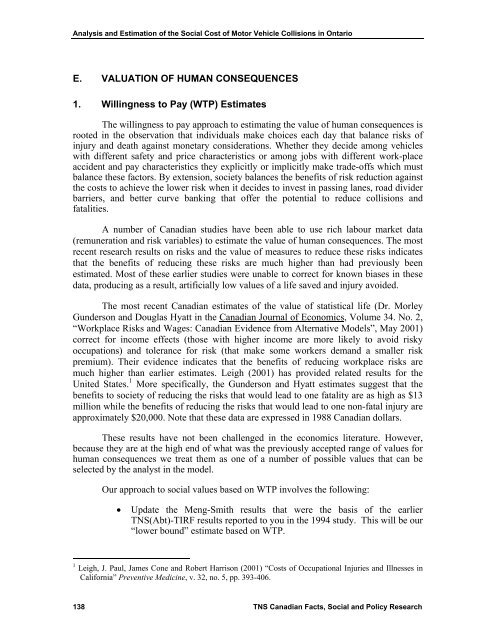Keith Vodden Dr. Douglas Smith - Transports Canada
Keith Vodden Dr. Douglas Smith - Transports Canada
Keith Vodden Dr. Douglas Smith - Transports Canada
Create successful ePaper yourself
Turn your PDF publications into a flip-book with our unique Google optimized e-Paper software.
Analysis and Estimation of the Social Cost of Motor Vehicle Collisions in Ontario<br />
E. VALUATION OF HUMAN CONSEQUENCES<br />
1. Willingness to Pay (WTP) Estimates<br />
The willingness to pay approach to estimating the value of human consequences is<br />
rooted in the observation that individuals make choices each day that balance risks of<br />
injury and death against monetary considerations. Whether they decide among vehicles<br />
with different safety and price characteristics or among jobs with different work-place<br />
accident and pay characteristics they explicitly or implicitly make trade-offs which must<br />
balance these factors. By extension, society balances the benefits of risk reduction against<br />
the costs to achieve the lower risk when it decides to invest in passing lanes, road divider<br />
barriers, and better curve banking that offer the potential to reduce collisions and<br />
fatalities.<br />
A number of Canadian studies have been able to use rich labour market data<br />
(remuneration and risk variables) to estimate the value of human consequences. The most<br />
recent research results on risks and the value of measures to reduce these risks indicates<br />
that the benefits of reducing these risks are much higher than had previously been<br />
estimated. Most of these earlier studies were unable to correct for known biases in these<br />
data, producing as a result, artificially low values of a life saved and injury avoided.<br />
The most recent Canadian estimates of the value of statistical life (<strong>Dr</strong>. Morley<br />
Gunderson and <strong>Douglas</strong> Hyatt in the Canadian Journal of Economics, Volume 34. No. 2,<br />
“Workplace Risks and Wages: Canadian Evidence from Alternative Models”, May 2001)<br />
correct for income effects (those with higher income are more likely to avoid risky<br />
occupations) and tolerance for risk (that make some workers demand a smaller risk<br />
premium). Their evidence indicates that the benefits of reducing workplace risks are<br />
much higher than earlier estimates. Leigh (2001) has provided related results for the<br />
United States. 1 More specifically, the Gunderson and Hyatt estimates suggest that the<br />
benefits to society of reducing the risks that would lead to one fatality are as high as $13<br />
million while the benefits of reducing the risks that would lead to one non-fatal injury are<br />
approximately $20,000. Note that these data are expressed in 1988 Canadian dollars.<br />
These results have not been challenged in the economics literature. However,<br />
because they are at the high end of what was the previously accepted range of values for<br />
human consequences we treat them as one of a number of possible values that can be<br />
selected by the analyst in the model.<br />
Our approach to social values based on WTP involves the following:<br />
• Update the Meng-<strong>Smith</strong> results that were the basis of the earlier<br />
TNS(Abt)-TIRF results reported to you in the 1994 study. This will be our<br />
“lower bound” estimate based on WTP.<br />
1 Leigh, J. Paul, James Cone and Robert Harrison (2001) “Costs of Occupational Injuries and Illnesses in<br />
California” Preventive Medicine, v. 32, no. 5, pp. 393-406.<br />
138 TNS Canadian Facts, Social and Policy Research
















